15 Amazing Dog Cakes
I celebrated my birthday this weekend – yay me! While I don’t normally like to make a big fuss (okay, that’s only partially true) it happens to be a big one and I’m going all out. There are two things I love in this world — ok five things, but: husband, family and Guinea Pigs- today is not about you, what I love most are dogs and cake, so today in honor of my birth, I’m going to talk about that.
Like so many other victims of the summer birthday, I watched as kids brought in cupcakes to class, knowing I would never get to experience such joys. Don’t get me wrong, my parents tried to throw me birthdays, but they ended up being more of the invite your favorite, few friends and hope for the best, as summer vacations and camps made it hard to plan. At the office we have a tradition of celebrating everyone’s birthday with a delightful feast, but alas I’m not at work either and so I’m left to celebrate myself, my way and why not? I’m the editor after all. It’s my party and I’ll write if I want to.
Before you find this to be too sad I should mention that I celebrated my birthday with a vacation and visits with friends and family exactly as I would like – it just doesn’t sound as funny when I say that.
So on that note, here are the 15 best dog-themed birthday cakes, I never had:
1. I love a cake with a little something extra to chew on.

Photo from Picsgen
2. This cake that looks a little too much like the real thing.
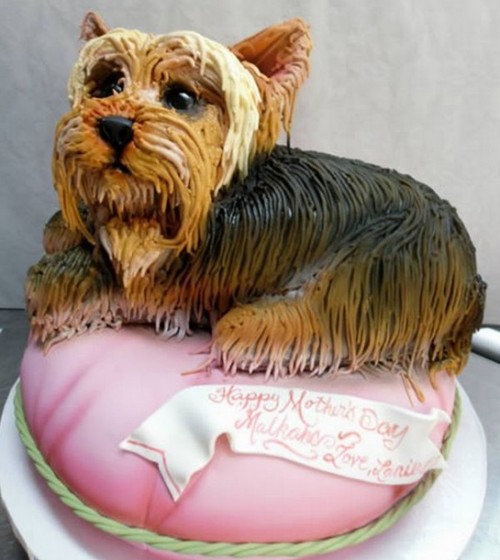
Photo from The-Cake-Lovers
3. No one likes to get walked all over, but I’m pretty sure it’s okay if these cute puppies walk all over my cake.

Photo by the FoodAdventure
4. I don’t discriminate, dog cupcakes are great too.

Photo from thecupcakeblog.com
5. I really “dig” this dog cake.
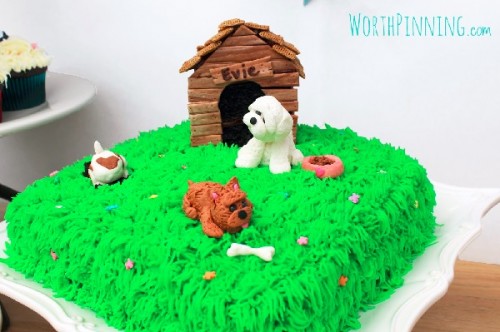
Photo from worthpinning.com
6. I’d be happy to take these guys on a walk… or a taste test.

Photo from pinkribbonbakery.ca
7. This lady like pup would be the perfect treat for any dog-loving, birthday girl.
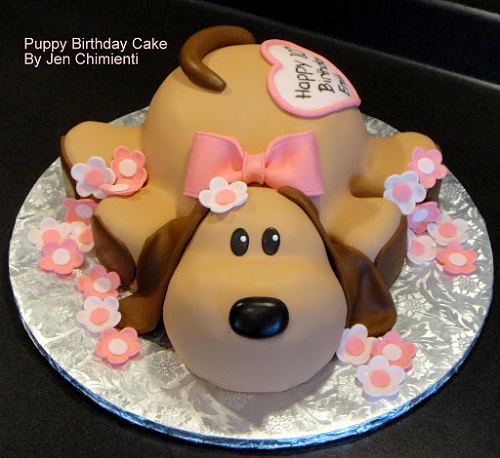
Photo from tipskidsparty.com
8. These soulful eyes are the true meaning of puppy love. This cake is certainly to “sweet” to eat.
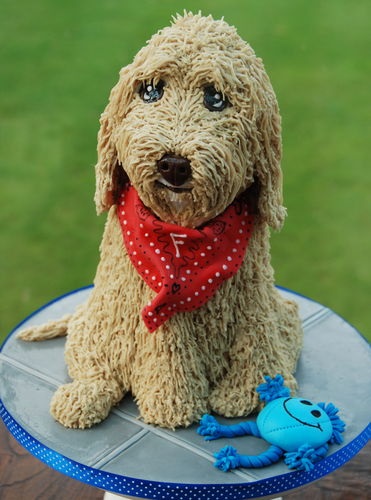
Photo from cakesdecor.com
9. If I was ever turned into a dog cupcake, I imagine it would look something like this.

Photo from the CupcakeBlog.com
10. We’ve all wondered what dog food might taste like.
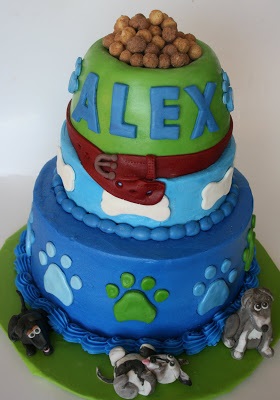
11. These Bulldog cupcakes don’t look excited to celebrate, but as an owner of a Frenchie I know that the look on the outside of these wrinkly pups doesn’t always match the sentiment within.

Photo from BaggyBulldogs.wordpress.com
12. Please someone make me this magical looking dog cake.

Photo from MaydenCake.blogspot.com
13. You should never give puppies as gifts, but a gift box with a dog cake, is totally okay.
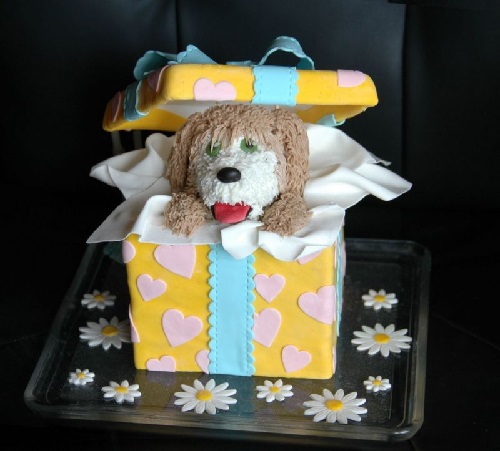
Photo from CakeCentral.com
14. You should always let sleeping dogs lie, especially if it’s their birthday.

Photo from TastyTreats.co.uk
15. If someone made a cake inspired by me writing about dog cakes, this is what it would look like.

Photo from Dahlia’s Cakes
Have you ever gotten a dog-themed cake or dessert for your birthday? Tell us about it in the comments below!
How to Brush Your Pet’s Teeth
When should you brush?
The best time to brush your pet’s teeth is when you are both relaxed. If your pet growls, bites, scratches or shows any other signs of aggression during the procedure, stop immediately and consult your Banfield doctor for advice.
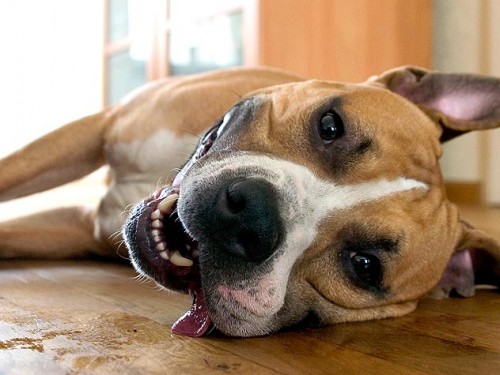
Step 1
Gently position your dog in a corner (of a sofa, chair or room) so that he will be secure and more easily handled. Carefully lift the lips to expose his teeth.
Step 2
Rub your finger over the dog’s teeth and gums for about 15 seconds to get the dog used to having something in his mouth. It might be necessary to do this a couple of times before the next step.
Step 3
Put a small amount of toothpaste specially formulated for pets on your finger, and allow the pet to taste it.
Step 4
Slide a finger brush onto your index finger and put a small amount of toothpaste on the brush. Gently rub the brush over your dog’s teeth and gums. Repeat this process for the next few brushing session. Because finger brushes are not as effective as regular toothbrushes, the pet should be transitioned to a regular bristled toothbrush as soon as the pet is comfortable with it.
Step 5
Apply a small amount of toothpaste to a bristle brush specially designed for pets. Place the brush bristles at a 45-degree angle to the gum line. Move the brush gently in circular patterns over the dog’s teeth. Start by brushing a few teeth. As brushing sessions continue, slowly include more teeth. Build up to about 30 seconds on each side of the dog’s mouth. Remember to brush both upper and lower teeth.
How to Stop Dog Mouthing
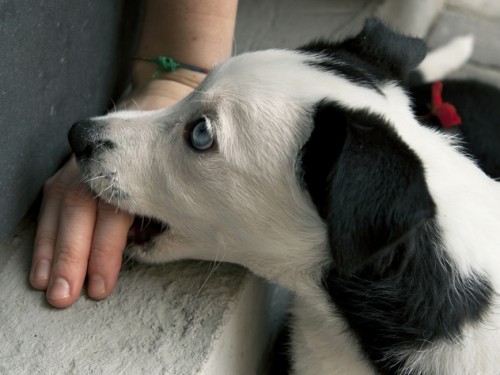
What is Mouthing?
“Mouthing is when a dog puts his teeth and mouth over a person’s skin while using little or no pressure from his jaw, says dog trainer and expert Mikkel Becker onVetstreet.com. “It’s not to be mistaken for aggressive biting, which is done out of fear or frustration.”
While mouthing may not be an aggressive behavior, it’s still frustrating and your dog could unintentionally hurt or scare someone, or the behavior could escalate into a bite.
Certified pet behaviorist and author Amy Shojai suggests using a two-pronged approach to curbing your dog’s mouthing behavior, starting with teaching “bite inhibition.”
Bite Inhibition
“Bite inhibition is a dog’s ability to control the force of nipping and mouthing,” according to Vetstreet.com. “A dog who hasn’t learned bite inhibition doesn’t recognize the sensitivity of human skin, so the dog nips and mouths too hard, even when playing.”
Puppies and young dogs typically learn bite inhibition during play with other dogs, according to author and dog expert Jennifer Bridell. When dogs play, they frequently use their mouths. If one dog bites too hard, the bite victim yelps and stops playing. This usually gives the biting dog pause. This is how dogs learn to control the force of their bites. Biting too hard means play time stops, and no one wants that to happen.
Amy Shojai recommends people use a similar approach when trying to teach their dog bite inhibition . The basic idea is to reward the desired behavior and redirect or ignore the unwanted behavior. This training will take patience and time, and the best results might come with working with a Certified Professional Dog Trainer or behaviorist.
Teaching Bite Inhibition
People can use strategies similar to puppy play to teach their dogs bite inhibition:
Allow your dog to mouth you during playtime.
Continue playtime until he bites hard.
When he bites hard, let out a puppy-style yelp, and then promptly stop “playing” by letting your hand go limp.
This should cause your dog to pause. When he does, praise him enthusiastically and resume play as normal.
Repeating this over and over should help him get the message. If it doesn’t, you can introduce brief time outs by stopping play all together and walking away after you yelp. After 20 seconds or so of calm behavior from your cutie, return to him and play with him again. This helps teach him that painful play is “bad,” and gentle play is “good.” Gentle play buys him more playtime, while painful play ends it. No fun there.
Continue this sequence. You should notice your dog’s bites progressively getting gentler and gentler – until they have little to no pressure.
After you’ve helped your dog learn to be gentle with his mouth, it’s time to teach him not to mouth people at all.
Teach Your Dog to Stop Mouthing
The experts at Vetstreet.com recommend the following techniques for getting your dog to stop mouthing you and other people:
Substitute a toy or chew bone when your dog mouths.
When you stroke your dog, offer him tasty treats from your other hand to discourage mouthing you as you pet him.
Encourage non-tactile games like tug-of-war instead of rough play , such as wrestling.
Help your dog learn to manage his impulses through activities such as “Leave it” and “Sit.”
If your dog likes to “ambush” your feet or ankles, stop moving as soon as he does this. Then, distract him with a toy. When he grabs the toy, continue moving.
Provide your dog with regular playtime sessions alongside other well-behaved canines. This can tire him out and make him less interested in strenuous play (and therefore mouthing behaviors) with you.
Common Dog Breeds for Degenerative Myelopathy

Breed Disposition
Degenerative myelopathy most often occurs in German shepherds and Welsh corgis. Other breeds predisposed to degenerative myelopathy include American Eskimo dogs, Bernese mountain dogs, borzois, boxers, Chesapeake Bay retrievers, golden retrievers, great Pyrenees, Kerry blue terriers, poodles, pugs, Rhodesian Ridgebacks, Shetland sheepdogs, soft-coated wheaten terriers and wire fox terriers.
DNA Testing
Researchers have identified the DNA mutations responsible for degenerative myelopathy. DNA tests are available to identify if a dog is clear, a carrier or are at increased risk for disease development. Talk to your veterinarian about the benefits of DNA testing.
Healing Puppy Power Put to Test for Childhood Cancer
Joshua sits on a hospital bed sobbing, surrounded by two nurses trying to insert an IV needle and by his Mom and Dad, trying their best to calm their scared and frightened four-year-old. But on this 6 a.m. Monday morning Josh, weary of his cancer battle, will have none of it. There have been too many needles. Now he is getting prepped for a third surgery. Joshua is a scared little boy and he knows what is coming, and he lets everyone within earshot know it.
Standing just outside the hospital room door I lift up my little therapy dog, Gordon, and we peek in. Immediately Josh’s Mom spots us, her eyes lighting up and she exclaims: “Josh, look, it’s Gordon! Gordon is here to see you.’’ They wave us in. Barely a minute or two later Josh is petting Gordon, sobs ebbing now into sniffles, focusing in our direction and his fluffy terrier pal, hardly noticing the IV connection being made on his other side.
A little dose of therapy dog can calm crying children, and ease the trauma and torment that sometimes comes with healing, for the patients, their families and the medical staff. A dog can make a sterile hospital room seem more like home, encourage kids who need to walk after surgery to get up and escort the pup around the hospital corridors, or just relieve the boredom of being stuck in a hospital room instead of being out with friends running around a playground.
In more than 6 years of making hospital visits with my wife Vicki, a longtime pediatric cancer researcher, and with our two therapy dogs, Gordon and Gypsy, we have seen them bring real therapy to thousands of people, both kids and adults. But until now there has been almost no real scientific “proof’’ of what therapy dogs contribute to healing, physical or mental.
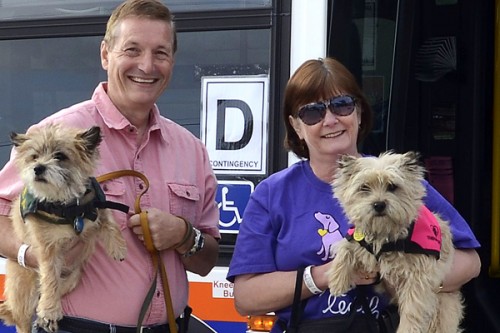
That may soon change.
The American Humane Association has teamed up with Zoetis and the Pfizer Foundation to launch a 15-month study designed to document the specific medical, behavioral, and mental health benefits animal-assisted therapy may have for children with cancer and their families.
“American Humane Association has a history of wanting science backing our initiatives,’’ says Amy McCullough, AHA’s National Director of Animal-Assisted Therapy. “In terms of animal therapy, obviously there is a gap there in terms of science supporting the benefits that we know sort of anecdotally that therapy dogs are giving us. With our mission being about helping both children and animals, we saw the need for this study to really promote how therapy dogs can help children who are dealing with cancer.’’
In exhaustive preliminary research, including a review of existing literature and a pilot study at two children’s hospitals, AHA found “therapy dogs are really important in pediatric oncology settings, and they aren’t allowed to visit necessarily in all children’s hospitals in these units, but the ones that we talked to really talked about the benefits.’’
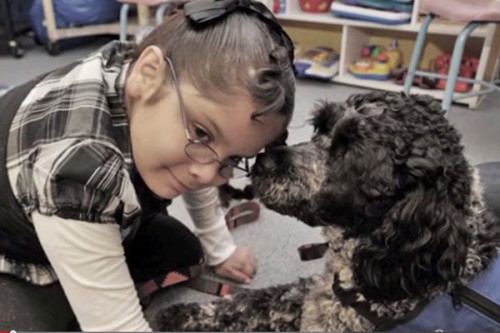
The full clinical trial will seek to confirm benefits identified in the pilot study, including:
Kids with cancer who are visited by therapy dogs have less stress, anxiety, and an improved, health-related quality of life
“Children with cancer and their families are not just dealing with physical concerns, there are also psychological issues – depression, anxiety, loneliness, being away from their classmates and school,’’ McCullough explains. “So these can have longer-term effects. We really want to show how animal-assisted therapy could be a really promising intervention to help not just the patient but the whole family interacts with the therapy dog, touching so many people there in a stressful situation.’’
Not only do the dogs themselves not get stressed by the visits, in fact the visits are mutually beneficial interactions
“The pilot study shows that post visit, the therapy dogs’ cortisol levels were lower than their baseline, indicating that they did not experience stress after visits,’’ McCullough says. “We also videotape the sessions using an ethogram to code the dogs’ behavior throughout the session, looking for signs of stress, whether it is yawning, lip-licking, looking toward the door, those kinds of things.’’
The five children’s hospitals participating in the study are:
St. Joseph’s Children’s Hospital in Tampa
Randall Children’s Hospital at Legacy Emanuel in Portland
UC Davis Children’s Hospital in Sacramento
UMass Memorial Children’s Medical Center/Cummings School of Veterinary Medicine at Tufts in Worcester/North Grafton, MA
Monroe Carell Jr. Children’s Hospital at Vanderbilt in Nashville
This study is personal to me and my wife. Today and every day, more than 35 children and their families will get a cancer diagnosis. In total, more than 40,000 children in the U.S. undergo cancer treatment each year.
Dog Heatstroke Survival Guide
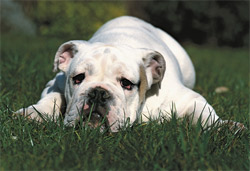
When my Pharaoh Hound, Logan, joined the family, I had the opportunity to try dog sports I had not yet experienced. It started out innocently enough with conformation events, but while working on conformation, I decided to try Logan in lure coursing. Logan turned out to be a natural, and has been awarded multiple Best-in-Field titles.
Agility, disc-dog competition, conformation and lure coursing are offered year-round, rain or shine. About a month ago, I experienced a problem I had never encountered. For the first time in almost a decade of competing in dog sports, one of my dogs experienced heatstroke. At a lure-coursing event, Logan became overheated. He’s completely recovered now, with no apparent long-term negative effects, but it was an experience that demonstrated firsthand how quickly this potentially life-threatening condition can arise.
What is heatstroke?
In simple terms, heatstroke occurs when a dog loses its natural ability to regulate its body temperature. Dogs don’t sweat all over their bodies the way humans do. Canine body temperature is primarily regulated through respiration (i.e., panting). If a dog’s respiratory tract cannot evacuate heat quickly enough, heatstroke can occur.
To know whether or not your dog is suffering from heatstroke (as opposed to merely heat exposure), it’s important to know the signs of heatstroke.
A dog’s normal resting temperature is about 100.5 to 102.5 degrees Fahrenheit. Once a dog’s temperature rises above 105 degrees, physiological changes start to take place, and the dog begins to experience the effects of heatstroke. At 106 to 108 degrees, the dog begins to suffer irreversible damage to the kidneys, liver, gastrointestinal tract, heart and brain.
If a dog is experiencing heatstroke, you may observe excessive panting; hyperventilation; increased salivation; dry gums that become pale, grayish and tacky; rapid or erratic pulse; weakness; confusion; inattention; vomiting; diarrhea; and possible rectal bleeding. If the dog continues to overheat, breathing efforts become slowed or absent, and finally, seizures or coma can occur.
The amount of damage a dog sustains when stricken with heatstroke depends on the magnitude and duration of the exposure. The longer and more severe the exposure, the worse the damage will be.
What to do:
Pay attention to your dog. Recognizing the symptoms of heatstroke and responding quickly is essential for the best possible outcome.
Get into the shade. If you think your dog is suffering from heatstroke, move it into a shaded area and out of direct sunlight. Apply cool water to the inner thighs and stomach of the dog, where there’s a higher concentration of relatively superficial, large blood vessels. Apply cool water to the foot pads, as well.
Use running water. A faucet or hose is the best way to wet down your dog’s body. Never submerge your dog in water, such as in a pool or tub – this could cool the dog too rapidly, leading to further complications, including cardiac arrest and bloating.
Use cool – not cold – water. Many people make the mistake of using cold water or ice to cool the dog. When faced with a dog suffering from heatstroke, remember that the goal is to cool the dog. Using ice or extremely cold water is actually counterproductive to this process because ice and cold water cause the blood vessels to constrict, which slows blood flow, thus slowing the cooling process.
Don’t cover the dog. One of the keys to successfully cooling your dog is ensuring the water being placed on the dog can evaporate. Never cover an overheated dog with a wet towel or blanket. This inhibits evaporation and creates a sauna effect around your dog’s body. Likewise, don’t wet the dog down and put it into an enclosed area, such as a kennel. Any air flow during the cooling process is helpful in reducing the dog’s body temperature. Sitting with the wet dog in a running car with the air conditioner blowing is an ideal cooling situation.
Keep the dog moving. It’s important to try to encourage your dog to stand or walk slowly as it cools down. This is because the circulating blood tends to pool in certain areas if the dog is lying down, thus preventing the cooled blood from circulating back to the core.
Allow the dog to drink small amounts of water. Cooling the dog is the first priority. Hydration is the next. Don’t allow the dog to gulp water. Instead, offer small amounts of water that’s cool, but not cold. If the dog drinks too much water too rapidly, it could lead to vomiting or bloat.
Avoid giving human performance drinks. Performance beverages designed for humans are not recommended because they are not formulated with the canine’s physiology in mind. If you can’t get an overheated dog to drink water, try offering chicken- or beef-based broths.
9 Things You Need to Know About Your Senior Dog’s Diet Needs
Most dog owners eventually face the challenge of properly feeding a geriatric dog. About one-third of all dogs in the United States are 11 or older, and dogs have an average life span of about 14 years, says Kathleen Hefner, DVM, a specialist in nutrition and nutritional counseling at the Animal Hospital of Saddle River in N.J.

Hefner emphasizes, however, that each dog is unique, so owners should consult their veterinarians and rule out any health problems before making dietary changes. All senior dogs are not the same, she says. You have to look at the more subtle things. You’ll want guidance on your individual pet’s needs.
But the majority of aging dogs face some common physical changes that require dietary changes to address them:
Dogs’ appetites can decrease as they age, so if they eat less, a calorie-dense diet can ensure they still get enough nutrients.
Dogs might also eat less because of pain from periodontal disease; more palatable, easier-to-chew food helps ensure Fido doesn’t go hungry.
Phosphorous and sodium can aggravate kidney problems, heart disease, and hypertension. If your dog has these illnesses, look for a diet with less of these two elements.
A sufficient amount of zinc helps keep the skin, coat, and immune system healthy.
Antioxidants, such as vitamins A, C, and E, and beta-carotene, are all believed to fight cancer and slow aging, so owners may want to supplement these if their dogs’ food doesn’t already include sufficient amounts.
Additives for joint health, such as glucosamine and chondroitin, often ease the aches of arthritis by maintaining the healthy cartilage that cushions the bones. Many senior dog foods include these ingredients, also available as supplements.
Aging dogs tend to have more gastrointestinal distress, so a diet with increased fiber can help prevent constipation.
Older dogs still require protein – vital to the body for cell repair and muscle maintenance – but can’t metabolize it as efficiently. They need higher-quality protein with a complete range of essential amino acids.
The omega-3 fatty acids found in fish oil and flaxseed oil can help alleviate a dull, dry coat and dry skin, as well as aid immune-system function.





